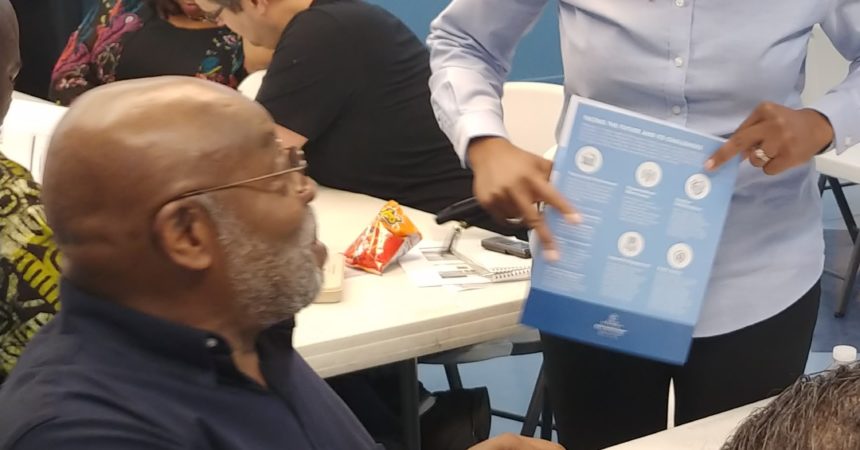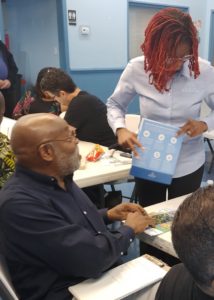
City, residents seek information at affordable housing meeting

The city’s Interim Director for Housing and Human Services, Abena Ojetayo, answers a question at last week’s meeting.
Photo by St. Clair Murraine
By St. Clair Murraine
Outlook staff writer
City representatives spent the last two weeks doing fact-finding that they plan to use in identifying affordable housing needs and community projects in line with the city’s consolidated plan.
The city uses the plan to secure funding through the Department of Housing and Urban Development and other sources. The meetings were held at four venues, the last two taking place at Smith-Williams Center on the Southside and the Lincoln Neighborhood Center in Frenchtown.
The second of three meetings on the Southside was held in the Oliver Hill Center at Orange Avenue Apartments last Tuesday. Similar meetings to gather information are held every five years, said Abena Ojetayo, the city’s Interim Director for Housing and Human Services.
Most of the information that the city gets out of the meetings will come from what residents wrote during a breakout session. Each group was given index cards to write their concerns.
“The city really values community engagement and the opinions of our residents,” Ojetayo said. “You will see more and more engagements because our citizens care about what’s happening and we want them to know. We want transparency and we want them to be informed.”
The 35 people who showed up at the Hill Center heard details of the city’s Consolidated Plan, the Community Development Block Grant and the Emergency Solution Grant program.
Although state funding could figure into affordable housing, the focus during the meeting was on HUD funding. A handout showed a pie graph with the breakdown of money anticipated from HUD. It shows $1,852, 209 or 64 percent for Community Development Block Grant projects; $160,982 or 6 percent for the Emergency Solution Grant and $876,318 or 30 percent for the HOME Investment Partnership Program.
While some people in the room seemed startled by the funding sources that are available through the city, it was announced that since the inception of the program 4,000 people have been helped through the emergency housing program. Sixty-two homes were brought up to code, 79 permanent homes established and approval was granted for 110 new homes.
During a question and answer segment, participants expressed plenty of concern about eligibility for affordable housing. Some like Erasmo Bocamegra came to see if the funding would be available to companies such as AOTD Property Services, which he and his son own.
They buy fixer-upper property, renovate them and sell or rent to people looking for affordable housing. The meeting was an eye-opener, he said.
“I think it was good because I need to get an audience with the city to see if we could get some kind of assistance or tax break,” Bocamegra said. “We need to buy more property.”
Bocamegra said he was driven into his line of work by empathy for low-income people.
“Just because you don’t make a lot of money doesn’t mean you have to live in a bad place,” he said.
One of the questions raised by Tifany Hill was about finding ways to improve funding to assist people who live in subsidized housing and are on a fixed budget. Hill said one of her relatives lives in a similar situation and sees a rise in rent whenever she receives a benefit increase.
“It’s a big problem there and that’s something they really need to look at when it comes to affordable housing,” said Hill, who once lived in the apartment complex where the meeting was held. “People are trying to eat better but they can’t eat better if they only have $100 left (after rent) because a part of that is going to have to go to utilities.”
Christic Henry, a realtor and an advocate for improving living condition in some areas of the Southside, said the intent of a Q and A meeting with the city is good, but it could be more useful with data.
She made her case by pointing out that three out of six parents that have kids in Title 1 schools have grandparents raising their children. She also said that about 3,000 people are searching for affordable housing in the city.
“I think we need to have information that drives our input,” Henry said. “To put us in a room and ask us what do you think about the community needs; that’s good. But the question is if our job is to be responsible stewards of needs. We need data.”
Ultimately, the meetings should produce the information that the city has to have to address housing and community needs, Ojetayo said.
“Over the years, this community has tried different things to see how can we help,” said Ojetayo. “Every five years we ask the same question; “is that what we want to continue to do?” or maybe are there other ways we need to focus our money.”







